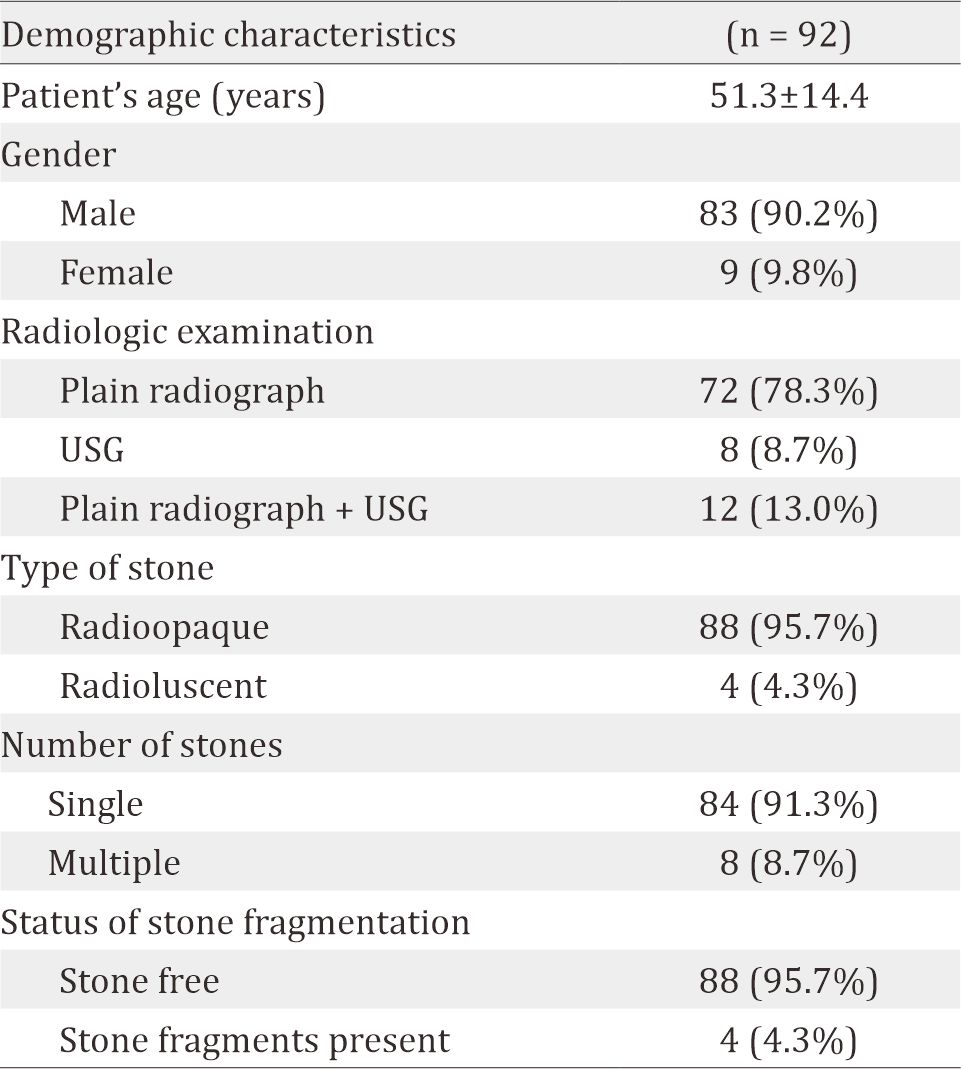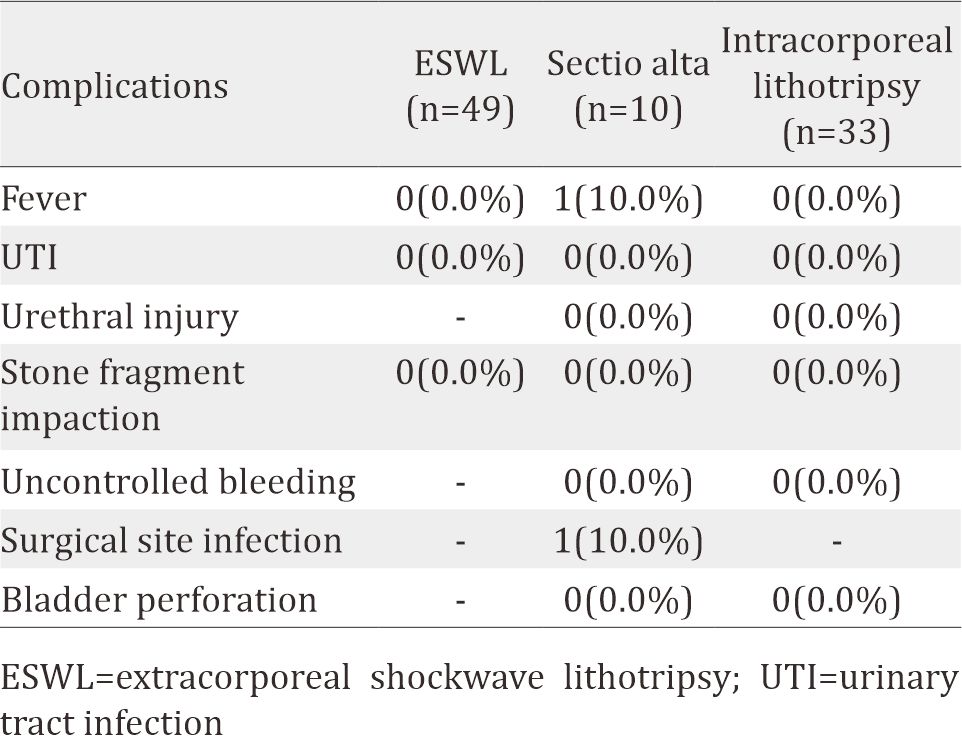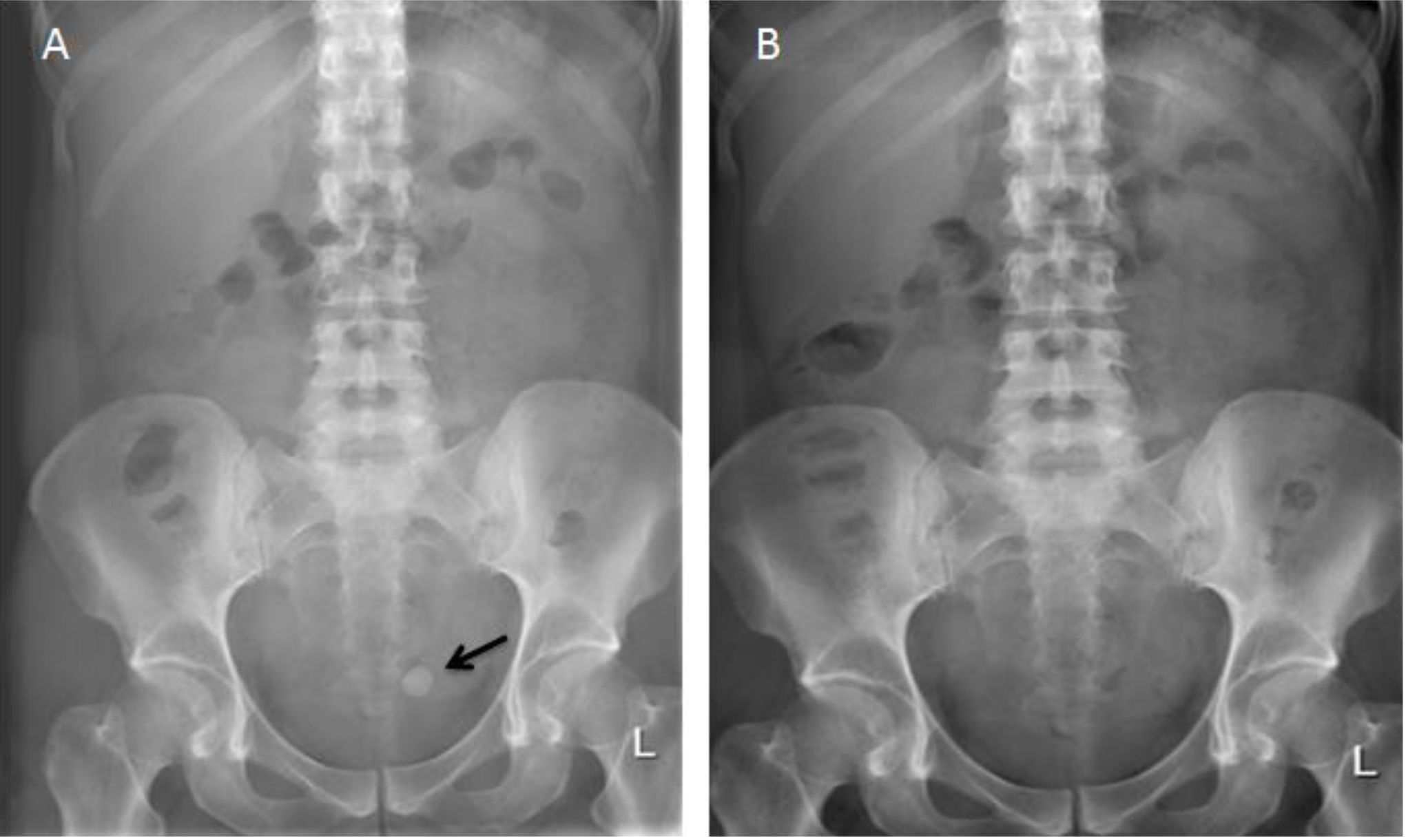
Section Abstract Introduction Methods Results Discussion Conflict of Interest Acknowledgment References
Clinical Research
Management of bladder stones: the move towards non-invasive treatment
pISSN: 0853-1773 • eISSN: 2252-8083
https://doi.org/10.13181/mji.v26i2.1602 Med J Indones. 2017;26:128–33
Received: October 06, 2016
Accepted: March 04, 2017
Author affiliation:
1 Department of Surgery, Faculty of Medicine, Universitas Indonesia, Cipto Mangunkusumo Hospital, Jakarta, Indonesia
2 Department of Urology, Cipto Mangunkusumo Hospital, Jakarta, Indonesia
Corresponding author:
Ponco Birowo
E-mail: ponco.birowo@gmail.com
Background
Bladder stone accounts for 5% of all cases of urolithiasis. Bladder stones management has evolved over the last decades from open bladder surgery (sectio alta) to intracorporeal cystholithotripsy as well as extracorporeal shock wave lithotripsy (ESWL). ESWL presents to be a promising modality in the management of bladder calculi due to its simplicity and well tolerability. This study is thus conducted to present data on the safety and effectiveness of ESWL in the management of bladder stone patients.
Methods
This is a retrospective study evaluating the medical records of 92 bladder calculi patients admitted to Cipto Mangunkusumo General Hospital (RSCM) from January 2011 to April 2015. Patient’s age, gender, type of stone and procedure being done, status of stone disintegration, length of hospital stay, and any complications that may occur are noted down and statistically analyzed using SPSS v. 20.
Results
Majority of the patients underwent ESWL (49 out of 92, 53.3%). The stone free rates for ESWL, intracorporeal lithotripsy, and sectio alta are 93.9%, 97.0% and 100% respectively. One patient had to repeat ESWL. The ESWL group had the smallest stone size average compared to the intracorporeal lithotripsy and section alta group (2.5 cm±2.0 cm vs 4.8 cm±3.7 cm vs 7.4 cm±5.4 cm respectively). The ESWL sessions were conducted in the outpatient clinic, and thus no hospital stay was required.
Conclusion
ESWL can be suggested as an effective noninvasive approach in the disintegration of bladder stone of ≤25 mm with a promisingly high stone-free rate (93.9%) Furthermore, ESWL can be performed on an outpatient basis with minimal complications.
Keywords
Bladder stone, cystholithotripsy, ESWL, sectio alta
The advent of antimicrobial treatment and improvement in nutritional intake has played a significant role in reducing the incidence of bladder stones in the last couple of decades. Nowadays, bladder stones or calculi represent approximately 5% of all cases of urolithiasis.1 Formations of bladder calculi are usually facilitated by the presence of bladder outlet obstruction, neurogenic voiding dysfunction, infection, as well as foreign objects.2 Some other additives, for example in melaminecontaining milk, had also been reported to cause formation of melamine-uric acid vesical stone in a child.3
Management options for bladder calculi are varied, and novel approaches have been developed in the last decades. Nevertheless, an ideal single approach to achieve stone clearance remained debatable due to the variations in stone burden and patient characteristics.2 In general, sectio alta is usually reserved for pediatric bladder stone and evacuation of large calculi(stone size >4 cm).2 This approach may also be indicated in hard stones that are refractory to endoscopic procedures. On the other hand, transurethral approach for bladder stone clearance provides an attractive alternative because it requires no incision (as it uses normal orifice) and permits the use of diverse tools for stone fragmentation. These include mechanical stone crusher, ultrasound, pneumatic and electrohydraulic lithotriptors, and combined ultrasonic/pneumatic lithotripsy device and laser energy sources, each of them with its own advantages and disadvantages.2,4–6 Alternatively, extracorporeal shock wave lithotripsy (ESWL) also presents a promising management for bladder stones due to its simplicity and tolerability. It is especially indicated in high-risk patients who are poorly tolerant to operative procedures.2 Additionally, ESWL is usually performed on an outpatient basis, does not require anesthesia and avoids prolonged urethral instrumentation.7,8 Many previous studies presented promising data on its efficacy as a monotherapy in bladder stone.9–11 Therefore, this retrospective study is conducted to explore the safety and effectiveness ofbladder stone management in the Cipto Mangunkusumo General Hospital (RSCM) who underwent ESWL.
METHODS
This is a retrospective study evaluating the medical records of patients who were admitted at the Cipto Mangunkusumo General Hospital with the diagnosis of bladder stones from January 2011 to April 2015. The confidentiality of the subjects identities was guaranteed. Case of bladder stones were diagnosed radiographically either by plain radiography or ultrasonography. Data regarding patient’s age, gender, type of stone, type of procedure being done, status of stone disintegration, days of hospital stay, and any complications that may occur are noted down. The Ethics Committee of the Faculty of Medicine, University of Indonesia, with regards of the protection of human rights and welfare in medical research, has carefully reviewed and approved this study with Ethical Clearance (No. 446/UN2.F1/ETIK/2016).
Patients who underwent ESWL were treated on supine position using PiezoLith 3,000 Plus–Richard Wolf. The number of shocks delivered in each session ranges from 4,000 to 6,000 shocks. After undergoing ESWL, the patients were re-evaluated by ultrasonography or plain abdominal radiograph at two weeks interval. Second ESWL session was indicated or conducted in the presence of significant stone fragment (>5 mm). Patients not undergoing ESWL underwent either intracorporeal lithotripsy procedure using electro-pneumatic lithotriptor (ELMED VIBROLITH) or cystolithotomy/sectio alta.
The data gathered in this study are analyzed using SPSS Statistics 20. The average age, stone size, and hospital stays in between different treatment groups (ESWL, intracorporeal lithotripsy, and sectio alta group) will be statistically analyzed using one way Anova to test whether there are statistically significant difference in various treatment groups in terms of average age, stone size, and duration of hospital stays. Post Hoc test will then be conducted to show the difference between treatment groups.
RESULTS
From January 2011 to April 2015, 92 patients had been admitted to the Cipto Mangunkusumo General hospital with diagnosis of bladder stone. They were mostly male patients (83 patients out of 92, 90.2%) with the average age around 51.3 (±14.4) years old. 78.3% (n=72) underwent plain abdominal imaging whereas only 8.7% (n=8) of them underwent ultrasonography (USG) examination. The rest of the patients underwent both radiographic examinations before being treated. The stones found from these patients are predominantly radiopaque (88 out of 92, 95.7%) and solitary in nature (84 out of 92, 91.3%) as shown in Table 1.
Table 1. Demographic characteristics

Majority of the patients admitted with bladder stone were managed by ESWL (49 out of 92, 53.3%) followed by intracorporeal lithotripsy (33 out of 92, 35.9%). Sectio alta was only performed in 10 out of 92 patients (10.9%). The stone free rate for ESWL, intracorporeal lithotripsy, and sectio alta are 93.9%, 97.0%, and 100% respectively (Table 2). Following the procedure, surgical site infection accompanied with fever was noted in one patient (1 out of 10, 10%) in sectio alta group (Table 3).
Table 2. Stone-free rate of each procedure

Table 3. Procedural complications

Overall, 49 patients out of 92 were treated with ESWL. One of these patients underwent ESWL for more than one session due to the presence of residual stone fragments two weeks post ESWL. The remaining patients underwent either intracorporeal lithotripsy or cystolithotomy. In general the average age of patients in ESWL and intracorporeal lithotripsy treatment group are similar (53.4±10.8 and 53.2±2.6 years old, respectively) and older than patients undergoing sectio alta (36.9±22.9 years old). One way Anova test shows that the mean age in between these three treatment groups are significantly different (p=0.004). However, Post Hoc test results have been inconclusive.

Figure 1. (A) Plain X-ray of patient with bladder stone (as indicated by black arrow); (B) Plain X-ray two weeks after last extracorporeal shockwave lithotripsy (ESWL) session
The average stone size was found to be the largest in patients undergoing sectio alta and the smallest in the ESWL group (7.4±5.4 and 2.5±2.0 respectively). Similarly, there was also significant difference in the average stone size (cm) in between the three groups. Tamhane Post Hoc test shows that this significant difference lies between ESWL and Intracorporeal lithotripsy group (2.5±2.0 vs 4.2±2.8 respectively, p=0.014). ESWL was conducted in an outpatient setting therefore no hospital stay was required. On the contrary, the average days of hospitalization were 4.8±3.3 and 10.9±8.2 days for Intracorporeal lithotripsy and sectio alta group respectively. On the other hand, however, Post Hoc test did not show significant difference in the duration of hospital stay between intracorporeal lithotripsy and sectio alta group. In general, patients who underwent sectio alta had longer duration of hospital stay (Table 4).
Table 4. Comparison between ESWL patients and patients from other treatment groups

DISCUSSION
Bladder calculi represents approximately 5% of all cases of urolithiasis1 with unique predisposing factors in different age groups and gender.2,3,12–14 In the early days, bladder calculi was first evacuated by open bladder surgery/sectio alta.15 Further development of endourology technique had also contributed greatly in the transurethral management of bladder stones (intracorporeal lithotripsy). Intracorporeal lithotripsy had also been commonly performed simultaneously with trans-urethral resection of prostate (TURP) in male patients of older population with history of bladder outlet obstruction caused by benign enlargement of prostate glands.5 Nevertheless, it is still being questioned whether performing TURP simultaneously with transurethral cystolitholapaxy is superior to medical therapy for benign prostate hyperplasia (BPH) alone.16
Both sectio alta and transurethral approach of stone evacuation are more advantageous than ESWL in the fragmentation of larger bladder stones. Nevertheless, both procedures have also a number of disadvantages since they must be performed under anesthesia, and long tedious postoperative hospital stay is inevitable. Additionally, transurethral approach also has several additional disadvantages such as longer operating time, hematuria, risk of bladder perforation, and potential urethral injury as their disadvantages.7,17 ESWL, on the contrary, is a non-invasive modality that utilizes high energy acoustic pulses generated outside the body.18 The effective applications of ESWL in disintegrating both radiopaque and radiolucent renal stones (e.g. uric acid stones) have been well described.19 Kostakopoulos et al,11 Al-ansari et al,20 and Telha et al21 have also mentioned ESWL’s role as a monotherapy in bladder stones fragmentation. The use of ESWL as a monotherapy in bladder stones, however, still has some controversial issues to address. The first is the fact that the recurrence rate of bladder stone after ESWL monotherapy is not well determined yet. This raises some debates on how long a patient needs to be followed up after an ESWL session.9 Secondly, there has also been some controversies regarding the proper patient positioning during the ESWL session. Some authors suggested a prone position17 while others recommended conducting the session in a supine position.10 Some authors prefered supine position because they assumed that in prone position, the sacrum might hinder stone fragmentation to some extent.21
In this study, 49 out of 92 patients underwent ESWL with stone-free rate of 93.9%. The stonefree rate observed in this study is comparable to the results gathered by El-Halwagy et al8 and Telha et al21 with stone-free rate of 96.6% and 95.5%.8,21 One case series of twenty patients with bladder stone with concurrent paraplegia have demonstrated 100% stone-free rate after ESWL session.22 The stone free rate of ESWL compared favorably to patients who underwent either intracorporeal lithotripsy or sectio alta (stonefree- rate of 97% and 100% respectively). Both these studies mentioned above, included patients in which ESWL is the first procedure performed for bladder stone management. This provides some suggestions that ESWL may be recommended to patient as the first line therapy before looking at other more invasive approaches. In this study, the success of ESWL in bladder stone treatment may be affected by the stone diameter. Apparently, the stone diameter of patients who underwent ESWL are significantly smaller than the patients undergoing intracorporeal lithotripsy and sectio alta (2.5±2.0 vs 4.2±2.8 vs 7.4±5.4 respectively, p=0.004). This finding in mean stone diameter in patients undergoing ESWL was similar to the study conducted by El-Halwagy et al8 (2.6±1.0 cm) and Kilciler et al22 (2.9±0.6). The smaller diameter of bladder stone in patients undergoing ESWL may be one of the determinants in the success rate. Other possible factors that may play a role in successful stone fragmentation in ESWL include the presence of bladder outlet obstruction and stone composition.2 Nevertheless, bladder outlet obstruction has been proven to have limited effect in ESWL’s success rate of stone fragmentation.8 Additionally, in this study, patients underwent ESWL on the outpatient basis, and thus no hospital stay was required. Moreover, after each ESWL session, clearance of stone fragments did not require any placement of urinary catheters.
This study, however, has a number of limitations. Firstly because this study is retrospective by nature. Confounding factors that may affect treatment’s success rate could not be minimized. Therefore, the impact of stone composition, urinary tract infection (UTI), stone burden, and presence of bladder outlet obstruction (BOO) on the treatment outcome could not be addressed. Secondly, this study also has a limitation in presenting the data of the recurrence rate of bladder stone after ESWL monotherapy. Additionally, this study also has limited data on the comorbidities in patients indicated to undergo ESWL treatment. These limitations can be tackled effectively if future studies in regards to ESWL monotherapy in bladder stone cases are conducted prospectively.
In summary, ESWL is a promising modality in the fragmentation of bladder stones. It provides a relatively high stone-free-rate (93.9%), can be done on an outpatient basis, and at the same time minimizes the need for anesthesia and urethral instrumentation with minimal complications. Therefore, ESWL can be suggested as a definitive treatment in patients with bladder stone of ≤25 mm in size especially in those with high anesthetic complications.
Conflicts of Interest
The authors affirm no conflict of interest in this study.
Acknowledgment
Much gratitude to all staffs of the Department of Urology, Cipto Mangunkusumo General Hospital in helping to make the construction of bladder stone patient’s database possible.
REFERENCES
- Schwartz BF, Stoller ML. The vesical calculus. Urol Clin. 2000;27(2):333–46.
- Papatsoris AG, Varkarakis I, Dellis A, Deliveliotis C. Bladder lithiasis: from open surgery to lithotripsy. Urol Res. 2006;34(3):163–7.
- Grases F, Costa-Bauzá A, Gomila I, Serra-Trespalle S, Alonso-Sainz F, del Valle JM. Melamine Urinary Bladder Stone. Urology. 2009;73(6):1262–3.
- Sofer M, Kaver I, Greenstein A, Bar Yosef Y, Mabjeesh NJ, Chen J, et al. Refinements in treatment of large bladder calculi: simultaneous percutaneous suprapubic and transurethral cystolithotripsy. Urology. 2004;64(4):651–4.
- Shah HN, Hegde SS, Shah JN, Mahajan AP, Bansal MB. Simultaneous transurethral cystolithotripsy with holmium laser enucleation of the prostate: a prospective feasibility study and review of literature. BJU Int. 2007;99(3):595–600.
- Kara C, Resorlu B, Cicekbilek I, Unsal A. Transurethral cystolithotripsy with holmium laser under local anesthesia in selected patients. Urology. 2009;74(5):1000–3.
- Philippou P, Moraitis K, Masood J, Junaid I, Buchholz N. The management of bladder lithiasis in the modern era of endourology. Urology. 2012;79(5):980–6.
- El-Halwagy S, Osman Y, Sheir KZ. Shock wave lithotripsy of vesical stones in patients with infravesical obstruction: an underused noninvasive approach. Urology. 2013;81(3):508–10.
- Bhatia V, Biyani C. Extracorporeal shock wave lithotripsy for vesical lithiasis : initial experience. Br J Urol. 1993;71(6):695–9.
- Husain I, el-Faqih SR, Shamsuddin A, Atassi R. Primary extracorporeal shockwave lithotripsy in management of large bladder calculi. J Endourol. 1994;8(3):183–6.
- Kostakopoulos A, Stavropoulos NJ, Makrichoritis C, Picramenos D, Deliveliotis C. Extracorporeal shock wave lithotripsy monotherapy for bladder stones. Int Urol Nephrol. 1996;28(2):157–61.
- Sharma R, Dill CE, Gelman DY. Urinary bladder calculi. J Emerg Med. 2011;41(2):185–6.
- Chen Y, DeVivo MJ, Lloyd LK. Bladder stone incidence in persons with spinal cord injury: determinants and trends, 1973-1996. Urology. 2001;58(5):665–70.
- Benway BM, Bhayani SB. Lower urinary tract calculi. Campbell-walsh urology. 10th ed. Philadelphia: Saunders. 2007. p. 2521–2527.
- Sánchez-Martín FM, Hostalot AM, Santillana JM, Angerri O, Millán F, Villavicencio H. Extraction of a bladder stone in a child as described by the renaissance physician Cristóbal Méndez. Actas Urol Esp. 2014;38(7):476–82. Spanish.
- Philippou P, Volanis D, Kariotis I, Serafetinidis E, Delakas D. Prospective comparative study of endoscopic management of bladder lithiasis: is prostate surgery a necessary adjunct? Urology. 2011;78(1):43–7.
- Bhatia V, Biyani CS. A comparative study of cystolithotfipsy and extracorporeal shock wave therapy for bladder stones. Int Urol Nephrol. 1994;26(1):27–31.
- McAteer JA, Evan AP. The acute and long-term adverse effects of shock wave lithotripsy. Semin Nephrol. 2010;28(2):200–13.
- Sun XZ, Zhang ZW. Shock wave lithotripsy for uric acid stones. Asian J Surg. 2006;29(1):36–9.
- Al-ansari A, Shamsodini A, Younis N, Jaleel OA, Al- Rubaiai A, Shokeir AA. Extracorporeal shock wave lithotripsy monotherapy for treatment of patients with urethral and bladder stones presenting with acute urinary retention. Urology. 2005;66(6):1169–71.
- Telha KA, Alkohlany K, Alnono I. Extracorporeal shockwave lithotripsy monotherapy for treating patients with bladder stones. Arab J Urol. 2016;14(3):207–10.
- Kilciler M, Sümer F, Bedir S, Ozgök Y, Erduran D. Extracorporeal shock wave lithotripsy treatment in paraplegic patients with bladder stones. Int J Urol. 2002;9(11):632–4.
Copyright @ 2017 Authors. This is an open access article distributed under the terms of the Creative Commons Attribution-NonCommercial 4.0 International License (http://creativecommons.org/licenses/by-nc/4.0/), which permits unrestricted non-commercial use, distribution, and reproduction in any medium, provided the original author and source are properly cited.
mji.ui.ac.id